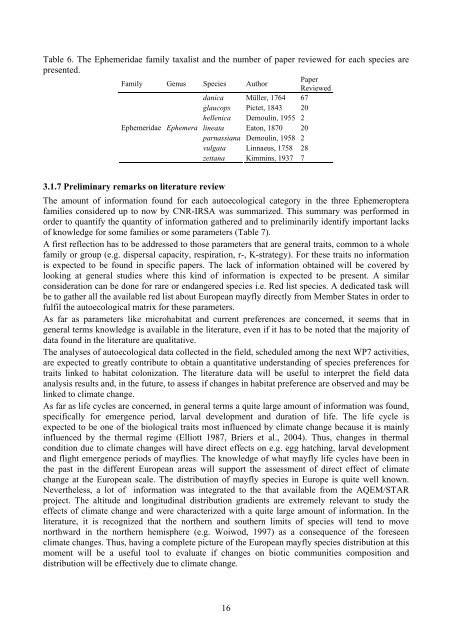Deliverable No. 189 Indicator value database for Ephemeroptera ...
Deliverable No. 189 Indicator value database for Ephemeroptera ...
Deliverable No. 189 Indicator value database for Ephemeroptera ...
Create successful ePaper yourself
Turn your PDF publications into a flip-book with our unique Google optimized e-Paper software.
Table 6. The Ephemeridae family taxalist and the number of paper reviewed <strong>for</strong> each species are<br />
presented.<br />
Family Genus Species Author<br />
Paper<br />
Reviewed<br />
danica Müller, 1764 67<br />
glaucops Pictet, 1843 20<br />
hellenica Demoulin, 1955 2<br />
Ephemeridae Ephemera lineata Eaton, 1870 20<br />
parnassiana Demoulin, 1958 2<br />
vulgata Linnaeus, 1758 28<br />
zettana Kimmins, 1937 7<br />
3.1.7 Preliminary remarks on literature review<br />
The amount of in<strong>for</strong>mation found <strong>for</strong> each autoecological category in the three <strong>Ephemeroptera</strong><br />
families considered up to now by CNR-IRSA was summarized. This summary was per<strong>for</strong>med in<br />
order to quantify the quantity of in<strong>for</strong>mation gathered and to preliminarily identify important lacks<br />
of knowledge <strong>for</strong> some families or some parameters (Table 7).<br />
A first reflection has to be addressed to those parameters that are general traits, common to a whole<br />
family or group (e.g. dispersal capacity, respiration, r-, K-strategy). For these traits no in<strong>for</strong>mation<br />
is expected to be found in specific papers. The lack of in<strong>for</strong>mation obtained will be covered by<br />
looking at general studies where this kind of in<strong>for</strong>mation is expected to be present. A similar<br />
consideration can be done <strong>for</strong> rare or endangered species i.e. Red list species. A dedicated task will<br />
be to gather all the available red list about European mayfly directly from Member States in order to<br />
fulfil the autoecological matrix <strong>for</strong> these parameters.<br />
As far as parameters like microhabitat and current preferences are concerned, it seems that in<br />
general terms knowledge is available in the literature, even if it has to be noted that the majority of<br />
data found in the literature are qualitative.<br />
The analyses of autoecological data collected in the field, scheduled among the next WP7 activities,<br />
are expected to greatly contribute to obtain a quantitative understanding of species preferences <strong>for</strong><br />
traits linked to habitat colonization. The literature data will be useful to interpret the field data<br />
analysis results and, in the future, to assess if changes in habitat preference are observed and may be<br />
linked to climate change.<br />
As far as life cycles are concerned, in general terms a quite large amount of in<strong>for</strong>mation was found,<br />
specifically <strong>for</strong> emergence period, larval development and duration of life. The life cycle is<br />
expected to be one of the biological traits most influenced by climate change because it is mainly<br />
influenced by the thermal regime (Elliott 1987, Briers et al., 2004). Thus, changes in thermal<br />
condition due to climate changes will have direct effects on e.g. egg hatching, larval development<br />
and flight emergence periods of mayflies. The knowledge of what mayfly life cycles have been in<br />
the past in the different European areas will support the assessment of direct effect of climate<br />
change at the European scale. The distribution of mayfly species in Europe is quite well known.<br />
Nevertheless, a lot of in<strong>for</strong>mation was integrated to the that available from the AQEM/STAR<br />
project. The altitude and longitudinal distribution gradients are extremely relevant to study the<br />
effects of climate change and were characterized with a quite large amount of in<strong>for</strong>mation. In the<br />
literature, it is recognized that the northern and southern limits of species will tend to move<br />
northward in the northern hemisphere (e.g. Woiwod, 1997) as a consequence of the <strong>for</strong>eseen<br />
climate changes. Thus, having a complete picture of the European mayfly species distribution at this<br />
moment will be a useful tool to evaluate if changes on biotic communities composition and<br />
distribution will be effectively due to climate change.<br />
16

















